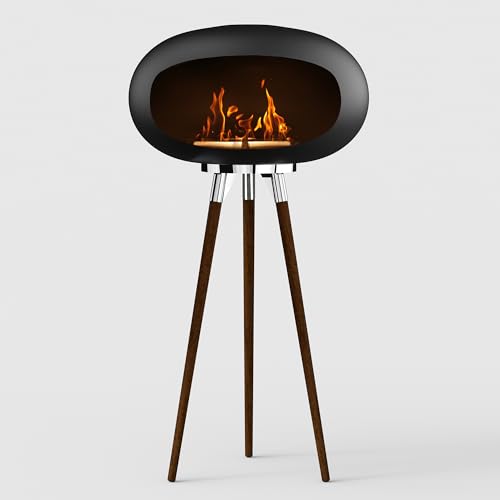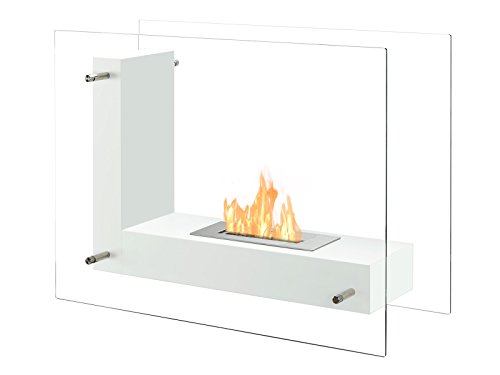You'll Never Be Able To Figure Out This Bio Ethanol Fire Free Standing's Tricks
작성자 정보
- Karry 작성
- 작성일
본문
 Bio Ethanol Fire Free Standing
Bio Ethanol Fire Free StandingA bio-ethanol fire freestanding is a modern fireplace which burns liquid ethanol fuel. It does not emit fumes or smoke, and is extremely easy to use.
 Simply add the bioethanol to the burner and let it burn. To put out the flame, simply put the closing rod over top of it to starve the oxygen.
Simply add the bioethanol to the burner and let it burn. To put out the flame, simply put the closing rod over top of it to starve the oxygen.Burn time
If you're a sustainable fire enthusiast You may have been prevented from putting a fireplace in your home due to the cost of wood-burning or gas options. With the advancement of technology bioethanol fireplaces are now an alternative. This type of fireplace uses liquid ethanol fuel that creates no smoke or fumes. It is also safe for indoor use and doesn't require a chimney or a flue. However, as with any fuel that is flammable, it's essential to be vigilant about the amount of fuel used, and be cautious when moving the unit around.
Bioethanol fireplaces come in various styles and are easy to set up. All you have to do is fill the burner box with bioethanol fire freestanding then ignite it and then relax in your new fireplace. Many models are designed to be portable, so you can move them from room to room with ease. You can even place them outside if you like. Make sure that your home is adequately ventilated to stop the buildup of carbon dioxide and other pollutants.
These fireplaces offer a traditional look, without the need to install chimneys. They don't produce smoke or emit fumes and are easy to install. Saving money on heating expenses is another benefit. Some models include fake flues to give a more authentic look.
There are two types of bioethanol fireplaces: inserts and wall mounted. Inserts are simple burners with glass shields to guard against the flame's open flame. It can be placed in virtually any fireplace to add a modern accent. You can select from a variety of inserts in different shapes and sizes to fit your space.
A wall-mounted bioethanol fireplace can be a great choice for those looking to add a modern freestanding bioethanol fireplace flair to their home. It's a great alternative to a wood-burning or electric fireplace, and it can be put in almost any spot in the home. They are also simpler to maintain than traditional fireplaces, and can be easily moved from room to room.
Safety
As long that the fire is set on a level surface and is kept a reasonable distance away from curtains and other flammable materials that are not flammable, a freestanding bio ethanol fireplace is safe to use. They don't emit carbon monoxide and the flames they produce are smaller than those of wood or gas stoves. They don't produce soot, smoke or require much cleaning. However, like any other kind of fireplace or fire one should be used in a well-ventilated room and should not be left unattended.
In addition to the fundamental safety precaution of keeping a fire in sight at all times, fireplaces made of ethanol must be properly installed and maintained to avoid damage and accidents. They must be constructed from sturdy materials and tested by an independent testing company to ensure they meet industry standards. Additionally the user's manual should clearly outline any risks that could be present and provide detailed precautions to take when using them.
The ethanol fuel that is burned in these fires comes by the fermentation of plant byproducts, such as sugarcane and grains with yeast. These products are less polluting than fossil fuels however they produce traces of carbon dioxide, and other gases which can irritate the lungs when breathed in. In addition, the crops that are grown for ethanol can divert land from being used to produce food.
Ethanol fireplaces are more secure than other fireplaces due to the fact that they don't have massive fuel tanks or connections that may leak or malfunction. However, they are not 100% safe as the fuel is a liquid and could spill out of the tank if the fire is knocked over or if you fail to switch off the fire when you leave the room.
If this happens, the flame will follow the fuel and spread to other areas of the room. It is possible to avoid this by keeping a fire extinguisher in the vicinity or by avoid touching the burner with your naked skin. It is recommended to open a window a bit when using a bio ethanol fire to let fresh air circulate around the room.
Ventilation
Proper ventilation is vital for fireplaces that burns bio-ethanol. Ventilation is essential to remove combustion byproducts and also allows fresh air to be introduced into the room. This will ensure a comfortable environment. Additionally, a properly vented fire can prevent carbon monoxide poisoning as well as other health concerns. Moreover, it helps to reduce humidity and increases the effectiveness of your heating system. Therefore, you should follow the manufacturer's instructions to ensure proper ventilation and that your home is adequately ventilated when you use a bio ethanol fireplace.
The majority of best freestanding bioethanol fireplace bio-ethanol fireplaces appear like wood fireplaces but, unlike wood stoves they don't require wood to burn. These fireplaces are powered by a liquid fuel known as bioethanol, which is produced from the discarded wastes of specific crops like sugar cane and corn. This fuel is cleaned and distillated before being used in the fireplaces.
These bio ethanol fireplaces are very adaptable, as they do not require chimneys or venting and can be moved to any area of the room. This flexibility is especially beneficial for homes or apartments with little space. In addition, bio ethanol fireplaces can also be placed outdoors, so long as they are protected from rain and wind.
Fireplaces come in various designs, from a simple cylinder shape to a traditional and rustic style. They can be set up on the wall or on a table and are available in various colors and materials. Some models can be recessed into a wall to create a stylish focal piece for your living area.
These fireplaces can be found at home improvement stores, specialty fireplace shops, and also online retailers. They are simple to maintain and can be used in any room. Ethanol fires are clean and emit no harmful gases, making them an environmentally-friendly alternative to wood or gas fireplaces. However, they may emit an unpleasant smell at first light, but this should dissipate quickly.
These fireplaces are safe but they must be kept a distance from curtains and flammable items. In addition, they should never be moved while they are burning, as it could cause burns or other damage to the surrounding. Keep them out of drafty places since they may generate smoke.
Installation
Ethanol fireplaces are a wonderful addition to any home and can be easily installed. They can be set up anywhere in the room, and do not require chimneys or gas pipes. They are powered by a liquid fuel made from renewable sources known as bioethanol. These fuels are cleaner and safer than fossil fuels like coal or oil, and they don't produce soot or ash. Ethanol fires do not release volatile organic compounds into the air, which can cause respiratory irritation and irritation to lungs.
There are a variety of styles of bio ethanol fireplaces available, from freestanding models to wall-mounted versions. The process of installation can differ according to the type of fireplace you choose. Most fireplaces come with directions to guide you in the correct way to install them. But the most important step is to ensure that you follow the manufacturer's guidelines for use. These guidelines will ensure that your bio-fireplace is safe and won't cause damage to any surfaces.
Most recessed ethanol fires have built-in tanks that store the fuel ethanol in liquid form. The tanks need to be insulated, and mounted to non-combustible walls. The ethanol burner should be kept at least one meters away from any combustible object like curtains or furniture. The tank should be kept in an area that is cool and dry, and out of the reach of pets and children.
Another benefit of a ethanol fireplace is that it is portable, meaning you can move it from one area to the next without a complicated installation. It is ideal for apartments and single-family homes, as well restaurants and hotels. It is easy to install, as it does not require a chimney or an electric connection.
Free-standing Ethanol fireplace freestanding fireplaces are a excellent option for homeowners looking to add a modern look to their homes. They do not produce gas or smoke They are therefore an excellent alternative to traditional wood fireplaces. They are easy to clean and operate. The only drawback to using a free standing bioethanol fires-standing ethanol fire is that it can be difficult to find bioethanol fuel in your area. You may have to order it online or from an artisanal retailer.
관련자료
-
이전작성일 2025.01.05 17:51
-
다음
댓글 0
등록된 댓글이 없습니다.
